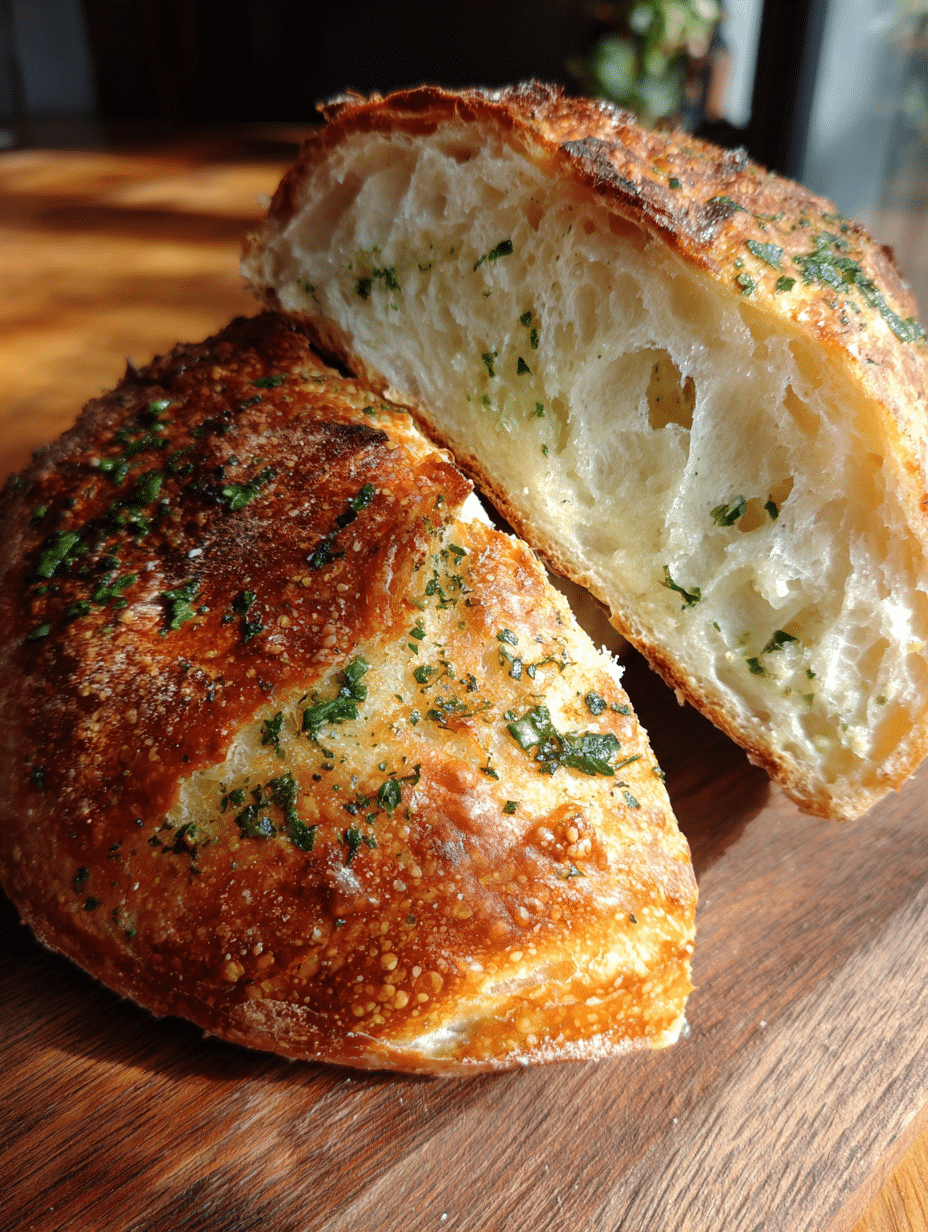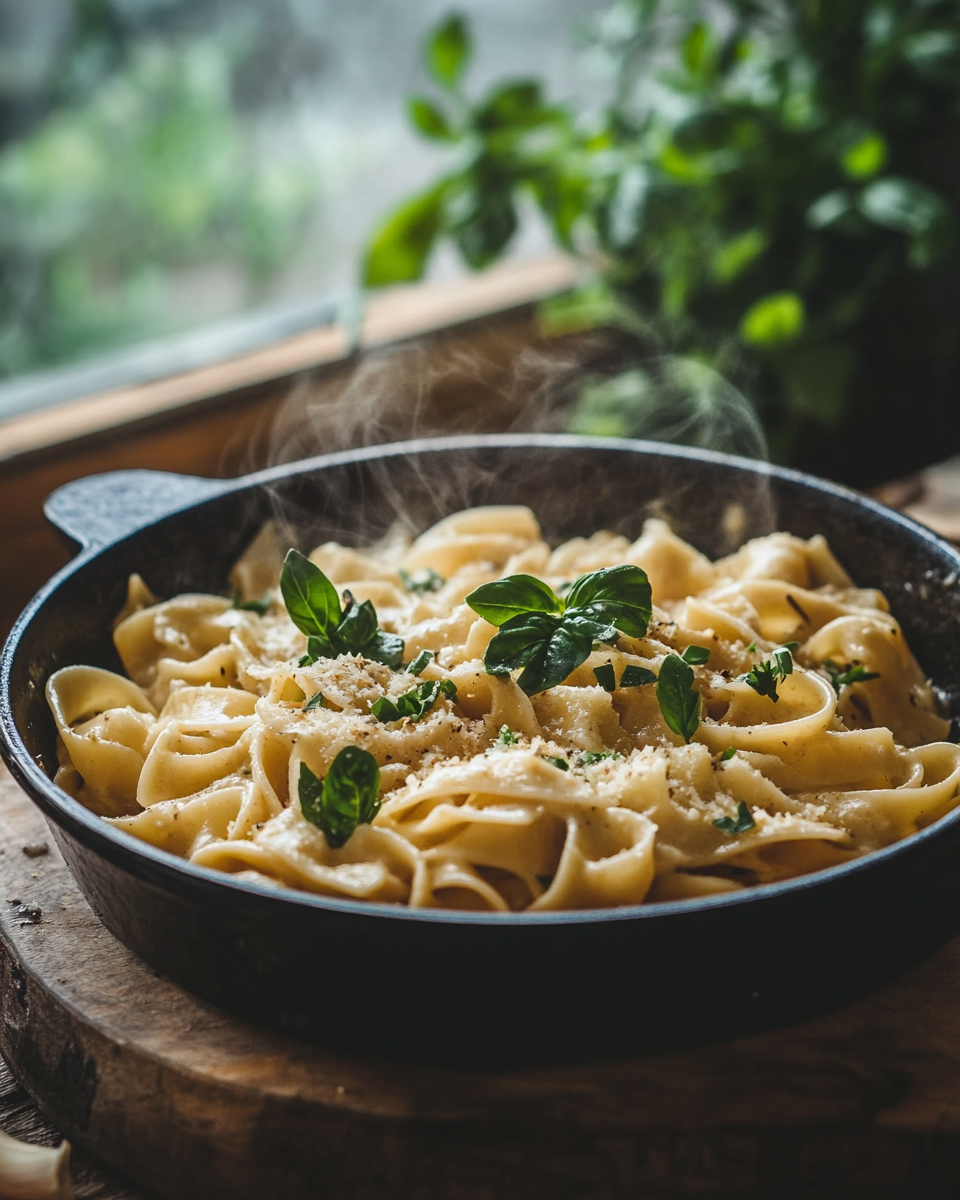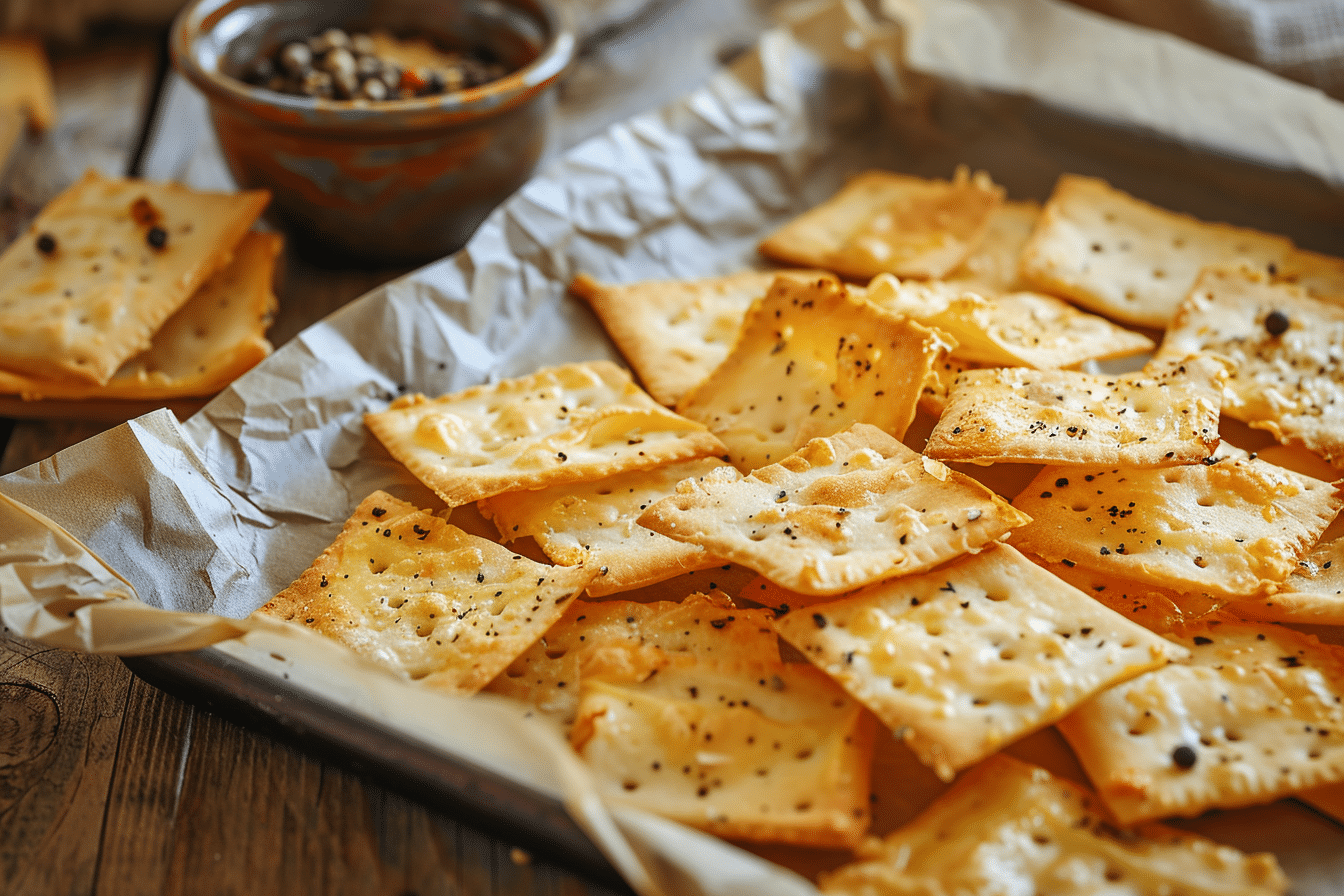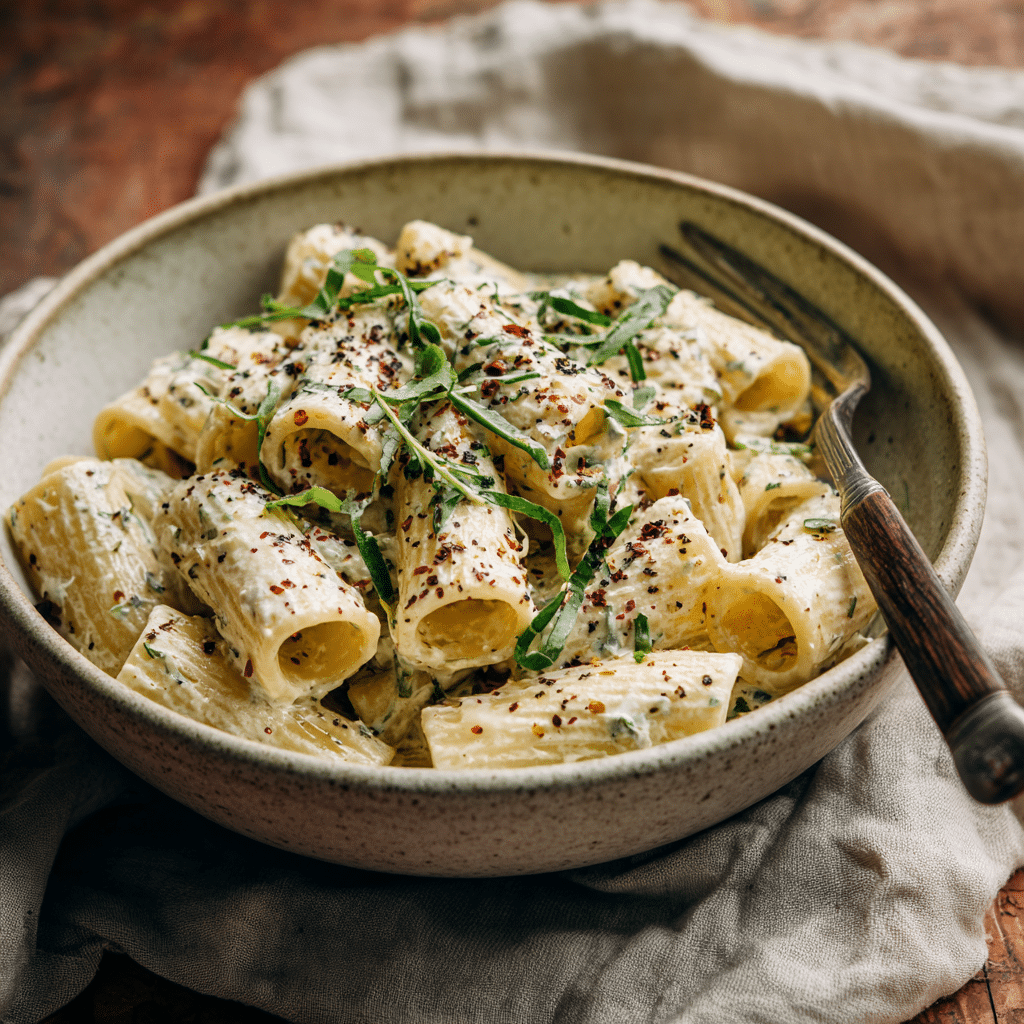Before we dive into the rich aroma of garlic, thyme, and fermented sourdough, here’s what we’ll explore in this article:
- A cozy story behind this savory loaf
- How garlic and herbs elevate traditional sourdough
- Step-by-step methods to make your loaf shine
- Tips for storage, serving, and pairing it with meals
Table of Contents

Garlic and Herb Sourdough Bread
- Total Time: 13 hours
- Yield: 1 loaf 1x
- Diet: Vegetarian
Description
This rustic garlic and herb sourdough loaf is loaded with flavor perfect with soups, sandwiches, or simply toasted with butter.
Ingredients
500g bread flour
1 tsp garlic powder
1 tsp dried thyme or rosemary
Pinch of black pepper
100g active sourdough starter
350–375g water
10g salt
Optional: Olive oil and flaky salt for crust
Instructions
1. Mix flour, garlic powder, herbs, and pepper.
2. Add water and mix until shaggy. Let rest 30 minutes.
3. Add sourdough starter and salt. Mix well.
4. Let rise for 4–5 hours with 3-4 stretch and folds.
5. Shape, place in proofing basket, and refrigerate overnight.
6. Preheat Dutch oven to 475°F. Invert dough into hot pot.
7. Score, brush with olive oil, sprinkle salt/herbs.
8. Bake 20 min covered, then 20–25 min uncovered.
9. Cool on wire rack before slicing.
Notes
Use garlic powder for even flavor and no bitterness.
Thyme or rosemary both work well—use what you have.
Brush with olive oil before baking for golden crust.
- Prep Time: 12 hrs (overnight proof)
- Cook Time: 45 minutes
- Category: Bread
- Method: Baking
- Cuisine: Rustic
Nutrition
- Serving Size: 1 slice
- Calories: 150
- Sugar: 0.5g
- Sodium: 210mg
- Fat: 1.5g
- Saturated Fat: 0.3g
- Unsaturated Fat: 1.2g
- Trans Fat: 0g
- Carbohydrates: 28g
- Fiber: 1g
- Protein: 4g
- Cholesterol: 0mg
Keywords: Garlic and Herb Sourdough Bread, sourdough, garlic bread, artisan loaf
Whether you’re a sourdough enthusiast or new to bread baking, this rustic recipe offers a flavorful twist that brings warmth to any table.
A Story of Sourdough, Garlic & Sunday Afternoons
Why Garlic and Herb Sourdough Bread Feels Like Home
Simple Twists, Deep Flavor
There’s a certain magic when sourdough bakes in my kitchen. The scent alone a bit tangy, a little nutty is enough to pause your day. But the first time I folded garlic powder and dried thyme into the dough? That was the moment my kitchen smelled like something out of a dream.
It was a quiet Sunday in West Lafayette. I had soup simmering on the stove and a small idea: what if I added herbs and garlic to my usual loaf? I reached for the thyme, a nod to my mom’s chicken soup, and black pepper for a subtle kick. Garlic powder felt like a no-brainer it brings that mellow, warm savoriness that just belongs in bread. When the loaf hit the oven, the smell was unbelievable like fresh air during a thunderstorm, but edible.
Now, this garlic and herb sourdough bread is in my regular rotation. It’s perfect sliced thick with salted butter, dipped into brothy soups, or made into hearty sandwiches like this cozy tuna melt. I even brush the crust with olive oil and sprinkle a bit of flaky salt before baking an easy upgrade that makes all the difference.
The best part? It doesn’t need to be complicated. You can mix these simple flavor boosters garlic powder, thyme or rosemary, black pepper right into the flour. Just like my garlic cheese sourdough, this loaf invites creativity. Want heat? Add a pinch of chili. Craving more crunch? Add seeds to the crust.
This isn’t just bread. It’s a way to turn everyday ingredients into something memorable something that tells a story in every slice.

Why Garlic and Herbs Belong in Your Sourdough Routine
The Flavor Science of Garlic in Bread
Herbs That Complement Sourdough Naturally
Garlic isn’t just delicious it’s transformative in bread. When baked into sourdough, garlic powder adds a mellow, nutty sweetness that complements the tang of fermentation without overpowering it. Unlike raw garlic, which can turn bitter when overbaked, powder distributes evenly and mellows into a warm, rich backbone of flavor. Combined with sourdough’s naturally tangy profile, the two create a rustic, comforting taste that feels like it’s always belonged.
You don’t need much. Just a teaspoon of garlic powder mixed into your flour (before hydration) goes a long way. It bonds to the dough, releasing its essence slowly during bulk fermentation and baking. You can also try roasted garlic for a deeper flavor, but garlic powder is the easiest entry point and doesn’t affect hydration levels.
Now add herbs, and the loaf becomes even more inviting. Thyme, with its earthy, lemony notes, brings freshness. Rosemary, sharp and piney, adds depth and texture. Both herbs stand up well to the long fermentation of sourdough, and when used dried, they don’t interfere with the dough’s rise. For balance, a pinch of black pepper cuts through the richness, elevating the entire bite.
Pair these flavors with a sourdough base like the one used in my easiest sourdough bread loaf and you’ve got something bold yet classic.
Want a sharper crunch? Sprinkle chopped rosemary or thyme on top with flaky salt before baking. For extra richness, replicate the brushed olive oil crust I used in these cheesy breadsticks.
Here’s a quick cheat table to help you balance flavors:
| Ingredient | Flavor Profile | Amount (per loaf) |
|---|---|---|
| Garlic Powder | Savory, mellow, slightly sweet | 1 tsp |
| Dried Thyme or Rosemary | Earthy, herbal, aromatic | 1 tsp |
| Black Pepper | Sharp, slightly spicy | Pinch |
With these simple additions, your sourdough takes on a whole new dimension rustic, rich, and layered.
How to Make Garlic and Herb Sourdough Bread – Step by Step
Easy Method Using Your Favorite Sourdough Starter
From Mix to Bake – It’s All in the Timing
This loaf starts just like your favorite sourdough recipe but the magic happens in the mix. Once you’ve got your active starter bubbly and ready, you’re only a few steps away from bread that tastes and smells incredible.
I typically use the base method from my go-to easy sourdough bread loaf, and then fold in flavor from the start. Here’s how I do it:
Step 1: Mix Your Flour and Flavor
Start with your regular sourdough mix say, 500g bread flour. Before adding water, whisk in:
- 1 tsp garlic powder
- 1 tsp dried thyme or rosemary
- Pinch of black pepper
This ensures even distribution before the hydration stage.
Step 2: Hydrate and Autolyse
Add 350–375g of lukewarm water and mix until shaggy. Let it rest 30 minutes.
Step 3: Add Starter and Salt
Add 100g active sourdough starter and 10g salt. Mix well.
Step 4: Bulk Fermentation + Stretch and Folds
Let the dough rest in a covered bowl at room temperature for 4–5 hours. Perform stretch and folds every 30 minutes during the first 2 hours.
Step 5: Shape and Rest
Shape into a boule or batard. Place into a well-floured proofing basket, seam side up. Cover and refrigerate overnight for 12–16 hours.
Step 6: Bake
Preheat your oven to 475°F with your Dutch oven inside. Carefully invert dough into the hot pot. Score the top, brush lightly with olive oil, and sprinkle flaky salt and herbs if desired. Bake covered 20 minutes, then uncovered for 20–25 minutes until deep golden brown.
Let cool on a wire rack then try not to eat it all at once!
Want a variation? Swap in rosemary and sea salt like I do in these sourdough crackers, or use this dough to shape garlic knots instead of a full loaf.
Serving, Storing, and Pairing Garlic and Herb Sourdough Bread
Best Ways to Serve This Savory Loaf
Storing It Right & Delicious Pairing Ideas
Once you’ve pulled this crusty, fragrant garlic and herb sourdough bread from the oven, the next question is: how are you going to enjoy it?
This bread is versatile cozy enough for simple butter-and-jam mornings, and bold enough to elevate weeknight dinners. My favorite way to serve it? Thick slices, lightly toasted, with a drizzle of olive oil or a slather of cultured butter. Try dipping it into this creamy tomato basil soup the herbs in the bread pick up beautifully on the soup’s richness.
Hosting a casual lunch? Make sandwiches with it! I’ve used this loaf for melty cheese stacks and even hearty protein-packed lunches like this classic tuna melt. The garlic gives the crust just enough punch to stand out, even with bold fillings.
Now let’s talk storage:
- Keep your bread wrapped in a cotton cloth or bread bag on the counter for 2–3 days.
- For longer storage, slice it and freeze the pieces in an airtight bag. They’ll toast perfectly straight from frozen.
- Avoid plastic it traps moisture and softens the crust too quickly.
Want a next-day idea? Turn leftover slices into garlic toast or even croutons. Just like I did with this pull-apart garlic bread, brushing olive oil and herbs on already-flavored sourdough creates an upgraded version of garlic bread that’s impossible to resist.
Planning to share? This loaf makes a wonderful edible gift wrap it in parchment and twine, and include a small pot of herbed butter or soft cheese. Rustic charm in every bite.
More recipes? Follow me:
Facebook – Pinterest
Frequently Asked Questions: Garlic and Herb Sourdough Bread
What herbs go well in sourdough bread?
Classic herbs that complement sourdough’s tangy flavor include rosemary, thyme, oregano, and sage. Dried herbs work best during mixing, while fresh herbs can be added just before shaping. For a fragrant crust, sprinkle a bit on top before baking just like in this garlic herb cracker variation.
How do you add garlic flavor to sourdough bread?
The easiest way is to use garlic powder, mixed directly into the dry flour before hydration. This ensures even distribution and prevents bitter spots. Roasted garlic cloves can also be folded in during shaping for a deeper, sweeter profile—similar to the method used in garlic knots.
Can I use dried herbs in sourdough?
Absolutely. Dried herbs like thyme and rosemary are ideal because they don’t affect hydration or fermentation. Add them during the initial flour mixing stage so they infuse throughout the dough. Dried herbs also hold up well through the baking process and retain flavor.
What is the best way to make sourdough bread more flavorful?
Enhancing sourdough’s flavor is all about fermentation time and thoughtful additions. Long cold proofing builds complexity. For added flavor, try mixing in herbs, spices, cheeses, or even ingredients like garlic and black pepper. Brushing the crust with olive oil and sprinkling flaky salt right before baking boosts both flavor and texture.
Conclusion
Garlic and herb sourdough bread is more than a recipe—it’s a ritual. The familiar aroma of garlic, the rustic charm of thyme or rosemary, and the deep flavor from natural fermentation all come together to create a loaf that comforts, nourishes, and impresses. Whether you’re pairing it with soup, using it for a sandwich, or simply enjoying it warm with butter, this loaf brings simple ingredients to life in a beautiful way.
It’s forgiving. It’s flavorful. And most importantly, it’s yours to make your own. Want more cozy ideas like this?
Follow me: Facebook – Pinterest






This looks amazing! Can’t wait to try it tonight! Did you use steam in the baking process?
Thank you! No steam needed for this one just bake as directed. Let me know how it turns out tonight!